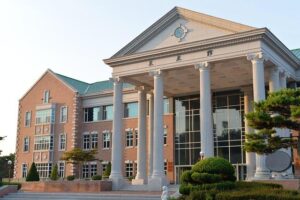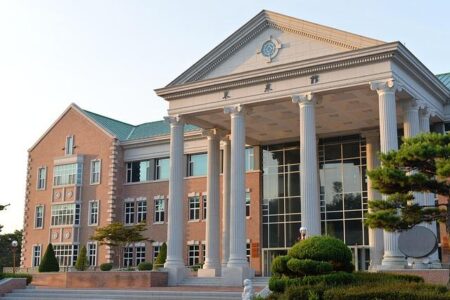San Diego Culinary Arts School, a standout project recently featured in eVolo | Architecture Magazine, exemplifies the innovative fusion of education and architectural design. This cutting-edge institution redefines culinary education through its dynamic space, reflecting contemporary trends in sustainability, functionality, and aesthetic appeal. As the culinary industry evolves, the school’s design sets a new standard for learning environments, highlighting how architecture can actively enhance creative and professional development.
San Diego Culinary Arts School Sets New Standards in Educational Design
The San Diego Culinary Arts School has reimagined educational spaces by integrating cutting-edge architectural design with hands-on learning environments. Its innovative layout prioritizes flexibility, enabling students and instructors to transition seamlessly between lecture halls, state-of-the-art kitchens, and collaborative breakout areas. This holistic approach not only enhances culinary training but also fosters creativity, teamwork, and real-world application of culinary skills in an inspiring atmosphere.
Key features of the facility include:
- Modular workstations that adapt to diverse culinary techniques and group sizes.
- Open-concept kitchen arenas designed to facilitate live demonstrations and interactive learning.
- Sustainability elements such as energy-efficient equipment and natural ventilation.
Such design choices represent a paradigm shift in how culinary education environments are conceived, setting new precedents nationwide.
Innovative Architectural Features Enhance Learning and Collaboration
At the heart of the San Diego Culinary Arts School lies a dynamic spatial design that fosters an environment where creativity and collaboration converge. The school’s layout integrates open-concept kitchens with flexible, movable partitions, allowing students to seamlessly transition between individual practice and team-based projects. Natural light floods communal prep areas, energizing the space and enhancing focus. This deliberate interplay between transparency and privacy cultivates an atmosphere where culinary innovation thrives alongside peer learning.
The building’s advanced technological infrastructure supports interactive educational experiences, featuring smart surfaces for live demonstrations and modular seating that encourages spontaneous brainstorming sessions. Key design elements include:
- Integrated audio-visual stations for immersive learning
- Eco-conscious materials that promote a sustainable studio environment
- Dedicated zones for sensory exploration and recipe experimentation
| Feature | Benefit |
|---|---|
| Open-Concept Kitchens | Encourages teamwork and visibility |
| Smart Surfaces | Facilitates real-time guidance and feedback |
| Movable Partitions | Enhances spatial flexibility for diverse learning modes |
Sustainable Materials and Energy Efficiency at the Forefront of the Campus
The San Diego Culinary Arts School integrates cutting-edge sustainable materials to reduce its environmental footprint dramatically. From reclaimed wood sourced from local demolished sites to low-VOC paints and finishes, every element has been chosen for its ecological impact. The building envelope features triple-glazed windows and high-performance insulation, drastically cutting down heating and cooling demands. Additionally, structural components utilize recycled steel, ensuring longevity while reducing resource extraction. This thoughtful approach fosters a healthier learning environment and aligns with the school’s vision of culinary education rooted in responsibility and innovation.
Energy efficiency takes center stage with an advanced system incorporating solar panels, geothermal heating, and smart energy management technologies. The rooftop photovoltaic array produces over 60% of the campus’s power needs, while energy consumption is optimized with motion-sensor lighting and demand-based HVAC controls. Explore the summary of key sustainable features and their benefits below:
| Feature | Benefit |
|---|---|
| Solar Photovoltaic Panels | Reduce grid dependency, 65% renewable energy supply |
| Geothermal Heating & Cooling | Stable temperature control, 40% energy savings |
| Recycled & Reclaimed Materials | Minimized resource depletion and waste |
| Smart Energy Management | Optimized power usage, real-time analytics |
| Low-VOC Materials | Improved indoor air quality and health |
Recommendations for Future Culinary School Developments Based on eVolo’s Model
Integrating eVolo’s visionary architectural principles into future culinary school designs can revolutionize how culinary education is approached worldwide. Emphasizing adaptability, these spaces should foster dynamic learning environments that transition seamlessly from individual instruction to collaborative workshops. Flexibility in spatial programming will enable culinary schools to respond promptly to emerging culinary trends and technological advancements. Moreover, incorporating sustainable building materials and energy-efficient systems aligns with global efforts towards reducing ecological footprints, simultaneously teaching students the importance of sustainability in gastronomy.
To harness eVolo’s innovative essence, future culinary institutions could implement the following strategies:
- Vertical integration: Utilizing multi-level layouts to maximize limited urban spaces without compromising functionality.
- Open-plan kitchens: Enhancing transparency and interaction between instructors and students to stimulate creativity.
- Technological hubs: Dedicated zones for food science laboratories and digital recipe archives to blend tradition with modern innovation.
- Community engagement areas: Spaces designed for public tastings and cultural exchange, enriching both the school and its local context.
| Key Aspect | eVolo Influence | Implementation Benefit |
|---|---|---|
| Modular Design | Interchangeable learning zones | Enhanced program versatility |
| Eco-conscious Materials | Recycled composites & natural light | Reduced energy costs & healthier environment |
| Vertical Expansion | Compact footprint | Optimized urban site usage |
In Retrospect
In summary, the San Diego Culinary Arts School by eVolo marks a significant addition to the city’s architectural landscape, merging innovative design with functional educational spaces. The project’s bold approach not only elevates the aesthetic standards of culinary institutions but also underscores the growing importance of adaptive, forward-thinking architecture in shaping learning environments. As the culinary arts continue to evolve, eVolo’s design serves as a promising blueprint for future educational facilities nationwide.







